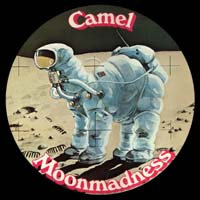

| Doug Ferguson: | Bass, Lead Vocal on Song Within a Song |
| Andy Ward: | Drums, Percussion, Voice on Aristillus |
| Peter Bardens: | Keyboards, Vocal on Spirit of the Water |
| Andy Latimer: | Guitars, Flute, Vocal on Song Within a Song, Another Night and Airborn |
Often voted as Camel's best album, Moonmadness is an impressive album. Most of it has a "Spacy"
or "Atmospheric" texture of sound, being totally different from the feeling
of Camel's earlier albums. It features some impressive instrumental, complex
parts, echoed, reverberating electric guitars (in a Pink
Floydian Shine on You Crazy Diamond style, perhaps)
and a significant switch to synthesizers. This is a classic progressive album, though the music
tends, somewhat, to fusion.
Another cover, from the (early ?) US Janus 7024 releases, featured a circular
picture of a the weeping Camel from the first debut album, now in a spacesuit
with a British emblem, standing on a lunar landscape. The inside cover has the
UK cover picture.
Note: A remastered edition of Moomnadness has been released in 2002 by Deram/Universal. This edition contains additional 32 minutes in five bonus tracks: Another Night (Single version), Spirit of the Water (demo), Song within a Song, Lunar Sea and Preparation/Dunkirk (live at the Marquee Club, April 14th 1976). Read a comparitive review of the two releases.
| During the short time they had to do make album, Camel were pressured into doing something 'a bit more commercial'. | |
| Moonmadness began as a loose concept album based on the personalities of the band members, Another Night - Doug Ferguson, Air Born - Andy Latimer, Chord Change - Peter Bardens, and Lunar Sea - Andy Ward. | |
| In Aristillus, the opening track, Andy Ward's voice on the background is saying "Aristillus Autolycus". Susan Hoover explains: 'The band thought it sounded like 'Aristillus ought to like us' and so Andy repeated it during the song because he was the only one who could say it over and over again without getting tongue-tied.'. Bill Thompson explains: 'Aristillus and Autolycus are two distinctive naked-eye craters (not lunar seas as best I can tell) on the near-side of the moon in the middle-upper-just-left-of-center area of the moon. They are very near the Apollo 15 landing site and are in the lunar sea named Imbrium.' | |
| The original cover was rejected by the US record company, hence the Camel in spacesuit in the original US release. | |
| "He was such an inventive drummer... blowing down a hose pipe into a bucket of water to create the intro on Lunar Sea" - Andy Latimer on Andy Ward. | |
| Although Ferguson worked with the band on the songs of their next album, Rain Dances, this is his last album with Camel . | |
| The Vinyl pressing of the album had a continuous sound of growling thunder recorded in the center groove that would play endlessly (well, unless the tone arm was lifted). This effect could not be repeated on the CD pressing... | |
| Ferguson introduced the band to saxophonist Mel Collins, who became a part-time player on their live gigs. Mel Collins also worked with King Crimson, Eric Clapton, Richard Wright, Dire Straits, Clannad and many more bands and artists. |
 | Passport PB 9857, Decca TXS-R 115, Janus JXS-3, Janus JXS 7024 Released in April 1976 (Concert programme claims March) |
 | Passport PB 9857, Janus JXSC-3 |
 | London 810 879-2, Janus JXS-7024, Janus 1332, Deram 8829312 |
| Total Playing Time: 39:27 | |
| Moonmadness reached 15 number in the charts |